The Ecological Effect Of Tree Elimination: What You Need To Know
The Ecological Effect Of Tree Elimination: What You Need To Know
Blog Article
Post Developed By-Dickey Cochrane
When it pertains to the environmental influence of tree elimination, there are important aspects that demand your focus. From the detailed web of connections within ecosystems to the subsequent results on environment patterns, the effects are extensive. You may be amazed to discover the elaborate ways in which the removal of trees can reverberate throughout the setting. Remain tuned to unravel the detailed connections and implications of this relatively uncomplicated act.
Deforestation and Environment Loss
Logging and habitat loss are crucial problems originating from tree elimination. When trees are cut down, it interferes with whole environments. Not only are the trees themselves shed, yet the homes and food sources of many plant and pet types are ruined too. Birds lose their nesting sites, creatures shed their sanctuary, and insects shed their environments. The results ripple through the food chain, impacting predators and prey alike.
In addition, deforestation adds to environment change. Trees play a crucial function in absorbing carbon dioxide, a greenhouse gas that catches heat in the ambience. With less trees, there's much less carbon dioxide absorption, causing enhanced degrees of this gas in the environment and worsening worldwide warming.
Habitat loss is a straight outcome of logging, as the destruction of woodlands suggests the loss of one-of-a-kind and varied ecosystems. Many species are unable to adjust to quick changes in their environment, leading to populace decreases and, sometimes, extinction.
Shielding forests is necessary to maintaining the delicate balance of nature and making certain the survival of countless plant and pet types.
Impact on Biodiversity
The removal of trees has a significant effect on biodiversity, impacting the range and wealth of plant and pet types in an area. Trees provide habitat and food resources for countless microorganisms, from pests to birds to animals. When https://cookware-and-diningware-l21100.estate-blog.com/32250104/future-directions-in-stump-grinding-modern-technology-significant-patterns-to-adhere-to are gotten rid of, these types shed their homes and resources of food, leading to a decrease in their populaces. https://vertikal.net/en/news/story/35130/tree-worker-injured-in-platform-collapse can have plunging effects on the whole environment.
Furthermore, trees play a crucial duty in keeping biodiversity by creating microhabitats within their canopies, trunks, and origins that sustain a wide variety of species. When trees are lowered, these specialized environments are damaged, decreasing the general variety of the location.
In addition, the elimination of trees can bring about a decrease in genetic diversity within plant populaces, as specific tree varieties may no longer have the ability to replicate or distribute properly. Protecting trees and woodlands is vital for preserving biodiversity and ensuring the health and wellness of environments for future generations.
Dirt Disintegration and Climate Modification
With trees being eliminated from an area, the disruption of dirt structure and security occurs, bring about increased soil disintegration. Trees play an essential duty in protecting against erosion by holding dirt in place with their root systems. When trees are gotten rid of, particularly in lots, the dirt ends up being much more vulnerable to erosion from wind and water. This erosion not just impacts the immediate environments yet can likewise bring about sedimentation in neighboring water bodies, impacting water quality and aquatic environments.
Moreover, trees assist control the environment by absorbing co2 throughout photosynthesis. When trees are cut down, this natural carbon sink is lessened, contributing to enhanced degrees of greenhouse gases in the environment. This can worsen environment change, bring about even more extreme climate events and interruptions in ecological communities worldwide.
Consequently, the elimination of trees not only speeds up soil erosion yet additionally plays a role in the larger ecological issue of climate change. It's essential to consider these aspects when evaluating the impacts of tree removal on the environment.
Final thought
Now that you know the ecological influence of tree removal, consider the consequences prior to reducing trees. Logging interferes with ecosystems, minimizes biodiversity, and contributes to dirt disintegration and climate modification. By being mindful of the influence of tree removal, you can help secure our environment and protect the fragile balance of nature. Make informed options and think about alternate options to minimize the negative results on our world.
